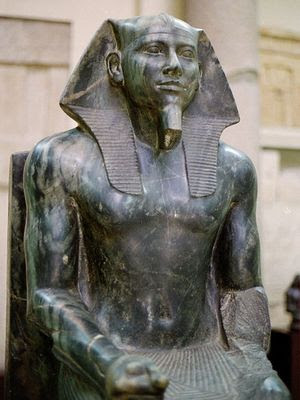King Khafre
King Khafre
He is one of the younger sons of Pharaoh Khufu, who lived and gained fame during the 26th century BC. He was also the fourth king of the Fourth Dynasty that ruled Egypt during the period between (2575-2465 BC), as he succeeded his half-brother Djedev Ra ( In English: Djedefra) in ruling, and he followed his approach in explaining the importance of worshiping the sun god (Ra), and called himself (Ibn Ra), and he ruled Egypt between (2558-2532 BC), and he who built the second pyramid of the pyramids of Giza It is worth noting that he had married four wives, of whom were: Kha Mar Nebti (English: Khamerernebti), and Mers Ankh III (English: Meresankh III). [1] [2] Although most of King Khafre's relatives were buried in tombs To some extent, cheap (for example, his brother, Djedev Ra, built his tomb in the Abu Rawash area), but Khafre did not consent to be buried in an unmarked cemetery, so he moved to Giza and built a tomb for himself next to his father’s tomb, which is the pyramid of Khafre. One of the three pyramids of Giza, and from what was mentioned in historical sources, one of his wives was buried in a great cemetery near his grave, and on the walls at her tomb were scenes depicting her with her short hair and her dress, which the queen wore from leopard skin, as her mother was shown. The second (in English: Hetepheres II) is next to her, and in this scene an embodiment of the power of these two women and their prominent role during the reign of King Khafre. [1] The pyramid of Khafre is a pyramid similar to that of Khufu, except that it is slightly smaller than it by a very small difference. Its height is 142.7 m, its side is 214.5 m long, and its angle of inclination is 53 degrees. [3] Although it is smaller and less high than Khufu's pyramid, it appears (from a distance) higher than it. Given that it was built at a height higher than its height, note that it can be accessed through its entrance located on the sea side at a height of 11 meters above ground level, and from the entrance a long corridor at the end of which is a room with a granite coffin, which is believed to be Pharaoh Khafre He was buried in it, just as the upper part of the pyramid is covered by a layer of limestone, while the lower part of the pyramid is covered by a layer of granite. [4] The temple of Wadi Khafre, which is a temple built of granite stones next to the pyramid, where a bridge extends between it, and the pyramid, and in Inside it are several statues of King Khafre, and the god Horus, known as (the falcon god). Because it takes the form of a falcon, noting that these statues are built from diorite stones that they used to bring from the Nubian desert, and next to the temple is a Sphinx that many believe bears the same characteristics of King Khafre in his appearance. [2] It is worth noting that the valley temple The pyramid of Khafra is the only one of the temples of the Old Kingdom that is still standing, and complete to this day, and archaeologists have revealed that there are two roads in front of the entrance to the temple that connect to the anchorage of the old canal located directly in front of the old building, and there were also found basins that are believed to be cleansing. The one in front of the Valley Temple, in which they placed the body of the king; To purify it with the water of the canal. [3] The statue of King Khafra This statue was made of diorite stones. For what is known for its permanence; An indication of the eternity of ownership of King Khafre, as for the shape of the statue, it depicts a mathematical body of a person in the prime of life, regardless of his real age. Artificial, which is a royal appearance for most of the pharaohs, even the female ones; The beard itself is found in the statue of Queen Hatshepsut, and King Khafre sits as depicted in the statue on the throne of Egypt, which is surrounded by strong lions, and other symbols of Egypt, such as papyrus. As for the falcon god Horus, he sits on the throne behind the king's neck, and in this An illustration of the extent to which King Khafre was associated with this god. [5]



Comments: 0
Post a Comment